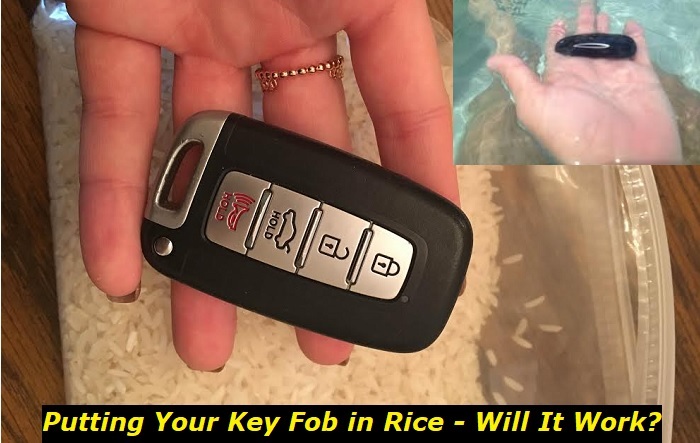You can put a wet key fob in rice; however, this common DIY method is not the most effective method to dry out your key fob. Rice can do more harm than good by leaving debris that might damage the internal components. Some of the best methods include detaching the battery, drying it with a clean cloth, or using silica gel packets.
Ignition problems highlights
- Level of urgency:high
- DIY inspection:possible but complicated
- DIY repairs:usually,impossible
- Can you drive?no
- Price of repairs:$5 - $350
- If ignored:no start
- Ways to fix:check batteries, try another key fob, inspect and locate the issue

Does Putting a Wet Key Fob in Rice Actually Work?
The rice drying method is a popular method for drying electronics, including key fobs. The idea behind this drying practice is that the rice acts as a drying agent while absorbing moisture from the wet device.
The effectiveness of drying a wet device depends on the ability of the drying agent to create an adequate drying environment. Rice, however, does not generate or circulate warm air, which is essential for evaporation.
The small rice particles can enter small ports in the key fob, which can cause blockage or damage to the key fob's internal components. With that in mind, here are some misconceptions and limits of using rice to dry were key fob:
- Though rice can absorb moisture, it is ineffective in drying key fobs.
- Rice grains are relatively large; therefore, their structure will not optimally absorb water.
- Using rice as a desiccant is a slow process- you need an effective response to avoid further damage.
So, instead of putting your key fob in a rice bag, you should opt for a more reliable and efficient method to dry your wet key fob.
What's the Best Way to Dry a Wet Key Fob?
Okay, forget about the rice trick. It's not going to do the job as well as you need it to. Not to worry though. Here, I have compiled some better solutions to dry your key fob. Just remember, your key fob sends signals to your car, so you must be careful while drying it to avoid any more damage.
Before you jump into the different methods for drying your wet key fob, follow these steps first:
1) Get Rid of Excess Water
As soon as you take the key out of the water, grab a soft cloth and gently wipe away any moisture from the surface of the key fob. Don't rub too hard, though. You definitely don't want the water to seep deeper inside.
2) Take Out the Battery
This step is crucial to prevent corrosion and leaks. If the battery is leaking, carefully remove it and use a cotton swab dipped in white vinegar to neutralize the battery acid. That should make it safe to clean. But if the battery is quite faulty and unresponsive, just replace it. After removing the key fob battery, clean the battery case and contacts with isopropyl alcohol. Make sure everything is totally dry before popping in the new batteries.
3) Pop Open the Key Fob
After you are done cleaning the battery and its case, the next step on the list is opening up your key fob. Some key fobs need an Allen-head or Phillips-head screwdriver, while others need a flat screwdriver. Whatever the case, open it up with care.
Once the key fob is open, give all the components a good drying. Pay special attention to that circuit board. Follow these steps to dry out the key fob components:
- Get a bottle of 90% isopropyl alcohol and some cotton swabs. Ensure you are wearing gloves, as skin contact can cause partial contact.
- Dip the cotton swab in the isopropyl alcohol to wipe the circuit board and the key fob interior.
- Set aside in a warm area and allow it to dry completely.
After following these steps, you can try the following drying methods:
4) Air Drying
Air Drying is one of the most effective ways to dry wet key fobs naturally. Place the key fob in a clean area with access to warm air circulation or, better still a clear, safe spot outside your house with access to a good amount of sunlight. To air dry your key fob:
- Locate a dry and warm area, with good air circulation and place the key fob on a clean paper towel.
- Keep the key fob buttons face-up to allow any moisture to drain out.
- Then, let it sit in the spot for at least 24 to 48 hours until completely dry.
5) Desiccant Packs
If you've encountered a wet key fob, desiccant packs can also come to your rescue. These packs, commonly found in new electronics or shoe packages, serve as effective drying agents for enclosed spaces. Here's a step-by-step guide on using desiccant packs to dry your wet key fob:
- Place two desiccant packs in a ziplock bag with your key fobs.
- Seal the bag tightly and leave it undisturbed in a suitable area for 24 to 48 hours. The desiccant packs will work to draw out the moisture from the key fob.
- After the designated time, reassemble the key components and test the key to check if it's functioning properly.
Remember, patience is key throughout this process. Allow the key fob to dry completely before proceeding. Once dry, reassemble the components, insert the battery, and test its functionality.
If, despite your efforts, the key fob still malfunctions, it may be necessary to seek professional assistance from a car service center. They can diagnose and repair any water damage or provide a replacement. However, if time is of the essence and you can afford it, getting a replacement key fob might be a more convenient option.
How Can You Keep Your Key Fob From Getting Wet?
If you have not experienced this unfortunate accident or purchased a new key fob, you can take preventive measures to avoid this problem. Keeping your key fob from getting wet is necessary to prevent any damage. Here are a few preventive measures you should consider:
1) Utilize a Waterproof Key Fob Case
Though it might be a bit pricey, you can invest in a waterproof key fob case and save yourself from spending more than necessary on a replacement in the future. These waterproof cases offer protective covers that seal your key fob, providing a barrier against water.
These protective key fob covers consist of durable silicone or plastic materials that snugly fit your key fob and keep it dry when it comes in contact with water.
2) Avoid Submerging Your Key Fob
Though most car key fobs come with waterproof cases that are water-resistant to an extent, they might get affected by water if you submerge them in water. Therefore, you should avoid testing its water resistance by submerging it in water or accidentally dropping the key fob in a pool.
3) Shield the Key Fob in a Sealable Plastic
You could also seal your key fob in a small sealable plastic or ziplock bag, especially during rainy conditions. This preventive measure keeps rain or other moisture sources from affecting your key fob. You can also secure the keys in a waterproof jacket pocket if the sealant bag will inconvenience you.
4) Keep Your Keys Away from Water-related Activities
If you plan to engage in any water activity, such as water sports, boating, or a trip to the beach, it is advisable to leave your keys in a safe, dry place. One option is to utilize a magnetic box that can be discreetly attached to your car's chassis.
This provides a secure storage spot for your keys while you enjoy your water-based activities. Just make sure to remember the combination lock information required to access the magnetic box.
Taking these proactive measures keeps your key fob from moisture damage and saves you the extra cost in case of water contact. Protecting your key will also help you maintain the key fob's functionality and longevity.
However, if your key fob experiences severe water damage or malfunctions despite all your efforts to dry the key, visit your car service center or a professional locksmith for repairs or replacement.
Final Words
Now that you have an idea, or rather, ideas about what to do about your key fob, you can disregard the rice drying method and opt for more effective methods to dry your key fob. Also, try to take timely action when dealing with your wet key fob, such as cleaning out your batteries and key interior, to minimize damage.
Remember that prevention is key; you can save more time and cost if you can protect your key fob from water damage.
About the authors
The CarAraC research team is composed of seasoned auto mechanics and automotive industry professionals, including individuals with advanced degrees and certifications in their field. Our team members boast prestigious credentials, reflecting their extensive knowledge and skills. These qualifications include: IMI: Institute of the Motor Industry, ASE-Certified Master Automobile Technicians; Coventry University, Graduate of MA in Automotive Journalism; Politecnico di Torino, Italy, MS Automotive Engineering; Ss. Cyril and Methodius University in Skopje, Mechanical University in Skopje; TOC Automotive College; DHA Suffa University, Department of Mechanical Engineering





Add comment